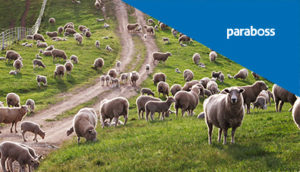Read the latest information on
Foot-and-mouth disease
 All livestock producers will be familiar with managing parasites. Monitoring, preventing spread and treatment are routine practices on many farms. Rightly so, too, as parasite burdens slow the growth of animals, negatively impact their health and welfare, and reduce productivity.
All livestock producers will be familiar with managing parasites. Monitoring, preventing spread and treatment are routine practices on many farms. Rightly so, too, as parasite burdens slow the growth of animals, negatively impact their health and welfare, and reduce productivity.
Getting parasite management right is vitally important, not only for the animals themselves, but for your business. A carefully considered, integrated management strategy for dealing with parasites should provide a return on investment, by minimising the impact of parasites on your flock or herd and extending chemical treatment effectiveness.
From slower growth to loss of condition, all the way through to the death of livestock. The lost value of livestock and livestock products as a result of parasite burdens, cost the industry sectors hundreds of millions of dollars annually.
While the many factors and seasonal conditions which determine parasite burdens vary greatly from region to region, understanding parasite risk and following an evidence-based program to control them doesn’t need to be challenging for producers.
ParaBoss has a suite of resources to help producers understand and implement best-practice parasite management within their businesses. Collectively, the WormBoss, FlyBoss and LiceBoss websites provide information, tools and resources for assessing parasite risks, choosing effective treatment and management strategies.
WormBoss provides information on assessing the extent of worm infection in sheep and goats, the proper use of anthelmintic products (i.e. drenches), and other non-chemical means of reducing worm contamination.
FlyBoss provides comprehensive tools which use local climate data to map flystrike risk. The website also provides information on breeding sheep to be less susceptible to flystrike, the use of chemical and non-chemical preventative strategies, and the proper means of treating fly struck sheep.
LiceBoss provides information on correct inspection techniques, lice eradication strategies, and selecting treatment products and application methods. A central theme of lice management, which will be familiar to regular readers of Farm Biosecurity News, is biosecurity planning to prevent lice infestations from gaining a foothold on your property.
While information across the three ‘Boss’ websites is provided for use by sheep producers (and goat producers, in the case of WormBoss), ParaBoss will soon be launching the WormBoss, FlyBoss, LiceBoss and TickBoss sites for cattle producers.
For producers wanting timely and effective information and advice on parasite management, the ‘Boss’ websites are accompanied by a twice-monthly newsletter which discusses the current state of parasite management and provides regular updates on best management practice by season. Sign up to receive newsletters and tap into the expertise of the ParaBoss network at on the ParaBoss website.
You can also join ParaBoss and ParaBoss Goats on Facebook at to see weekly posts on flystrike and lice for sheep, and worm control for sheep and goats.
This article has been contributed to Farm Biosecurity News by ParaBoss, with support given from Animal Health Australia.
ParaBoss is funded by Australian Wool Innovation and Meat & Livestock Australia and coordinated by the University of New England with industry oversight.